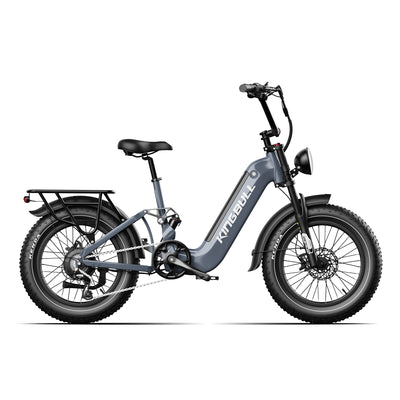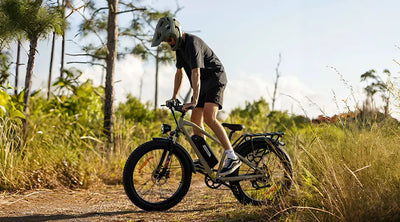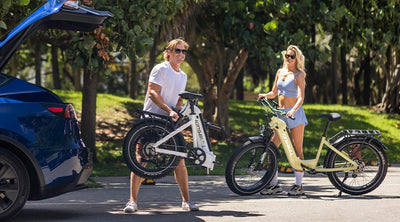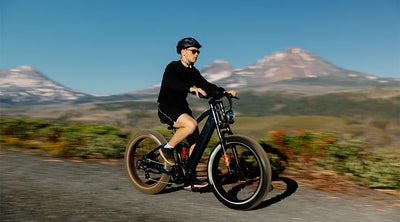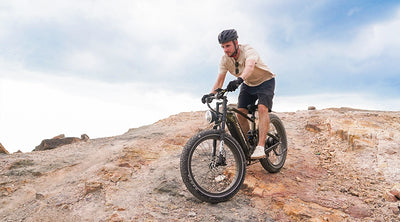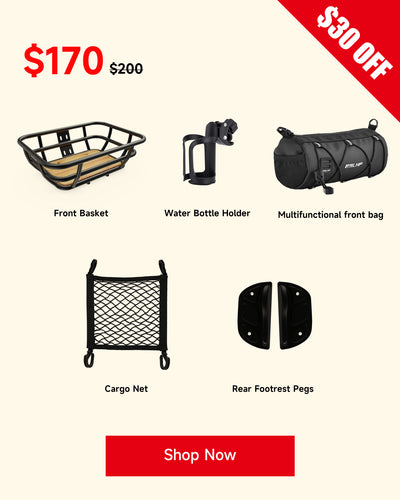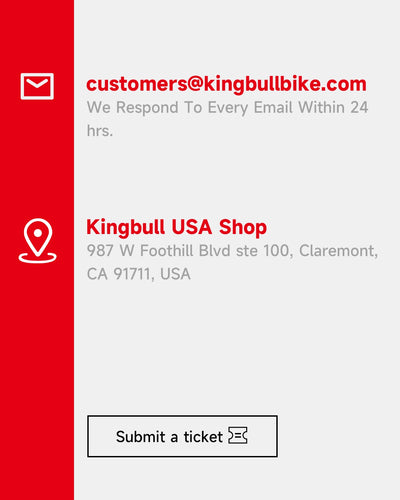Explore News

Tips & Cycling Knowledge
What Affects Electric Bike Speed Limits?
Why Are Electric Bikes Speed-Limited?
Electric bikes in the U.S. are distinct from other vehicles, primarily in terms of performance and regulations. Federal laws set the following requirements for e-bikes:
Motor power must be 750 watts or less.
Pedals are required for rider control.
The top motor-assisted speed is capped at 20 mph.
Riders can exceed 20 mph by pedaling or downhill riding, but the motor assistance stops at this limit. When going downhill, e-bike speeds may surpass the standard limit, but only due to pedal power or gravity. This design ensures e-bike safety and keeps usage consistent across various riding scenarios.
Why Set a Speed Limit?
E-bikes that meet these federal requirements can legally operate on most roads, lanes, and designated bike paths. While some models are built to exceed 20 mph, they're typically for off-road use. On public roads, exceeding speed limits can lead to violations. Some high-speed e-bikes available online are geared toward specialized or off-road use and are not intended for regular commuting.
In the U.S., a 20 mph speed limit is fairly generous. By comparison, European countries set a lower limit at 15 mph. Since average cyclists often don’t exceed 12 mph, the 20 mph cap for e-bikes is reasonably high.
E-Bike Speed Limit Categories
In the U.S., e-bikes are classified into three main types based on control, speed, and power:
Class 1: Pedal-assist only, providing motor support as the rider pedals, with a max assisted speed of 20 mph and up to 750 watts of power. This type is ideal for battery efficiency and extended range.
Class 2: Throttle-controlled, where the rider can use a throttle for direct electric power up to 20 mph. Unlike Class 1, this class allows full acceleration without pedaling.
Class 3: Higher motor support with a speed cap of 28 mph and usually equipped with a 750W motor. Depending on the regulations in different states, there may be age restrictions on the use of Class 3 e-bikes..
What Influences E-Bike Speed?
E-bike speed isn't just about legal caps; other factors play a role too:
Motor PowerMotor wattage is crucial. Higher wattage delivers more power, enhancing acceleration and quick-start performance. For example, a 750W motor offers stronger acceleration, especially useful for reaching higher speeds in a short time. Lower-wattage motors are more energy-efficient, ideal for city commuting and smooth rides.
Rider and Bike WeightCombined rider and bike weight affects speed and range. Heavier loads demand more motor power, which can lower speed potential.
Battery ChargeE-bikes perform best with a fully charged battery. As the battery drains, power output may reduce, affecting top speed. Many e-bikes automatically limit power at low battery levels to preserve range.
Terrain and Road ConditionsSpeed varies with terrain. Flat roads allow higher speeds, while gravel paths or steep inclines may require more effort to maintain speed. Downhill slopes, thanks to gravity, will naturally speed things up.
Weather and Environmental FactorsWeather can impact speed too. Headwinds create resistance, slowing down the ride, while tailwinds can boost speed. Extreme temperatures can affect battery performance, indirectly influencing speed.
Why Following Riding Regulations is Essential
E-bikes generally reach higher speeds than traditional bikes, so laws and speed limits are set to reduce accident risks and protect e-bike riders. Most regions ensure that e-bikes cut motor support upon reaching speed limits, leaving only pedal power to maintain momentum. These laws exist to keep e-bike riding safe and prevent potential traffic incidents.
Conclusion
Electric bikes are an ideal option for those seeking an efficient and easy riding experience, helping riders conserve energy while boosting enjlso important to follow regulations for safety. Higher speeds can increase risk, so choosing the right e-bike and operating it within safe limits is essential.
Read more
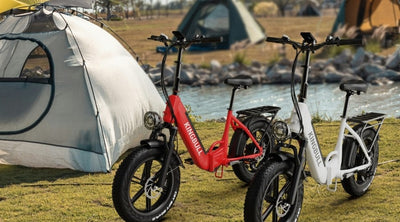
Purchase Guide
Could the Kingbull Literider, Priced Under $1000, Be the Sleek, Minimalist E-Bike You’ve Been Waiting For?
For those seeking style and functionality in an e-bike, the Kingbull Literider brings you just that. With its built-in battery for a streamlined look and an easy step-through design, this bike redefines what it means to be both practical and stylish. Let’s dive into the features that make the Literider a top choice for both urban commuters and recreational riders alike.
Integrated Battery for a Clean, Modern Look
Unlike many other e-bikes with bulky, external batteries, the Literider boasts a fully integrated 48V, 15Ah battery tucked seamlessly into the down tube. This design not only gives the bike a sleek, minimalist appearance but also adds an extra layer of security. With the battery out of sight, you can ride knowing it’s protected from the elements and potential theft.
The battery’s placement within the frame also enhances the bike’s balance, creating a smoother and more stable ride. And for convenience, it offers both on-bike and off-bike charging options.
Unique Step-Through Frame for Easy Access
The Literider’s thoughtful step-through frame isn’t just practical; it’s a game-changer for accessibility and rider comfort. With a low mounting height, this design makes it easy to get on and off the bike, regardless of age or mobility level. Ideal for seniors and anyone with balance or flexibility concerns, this feature adds a whole new layer of ease and independence to every ride.
While many e-bikes have traditional high-frame designs, the Literider’s step-through construction stands out as a unique, user-friendly alternative. Simply step on, sit back, and enjoy the ride!
Multiple Color Options to Showcase Your Style
The Kingbull Literider is available in various color options, allowing riders to choose a color that suits their personal style. Classic black and white are perfect for those who prefer a more understated look, while the vibrant red and green are ideal for riders looking to make a bold statement. This variety adds to the uniqueness of the Literider, meeting different style preferences.
More Features That Set the Literider Apart
Sturdy 20 x 4 Inch Fat TiresFat tires mean added stability, and on the Literider, they handle urban streets, gravel paths, and light trails with ease. Paired with a solid front suspension fork, the Literider is equipped to take you wherever you want to go in comfort.
Powerful Motor and Intuitive Pedal AssistWith its 750-watt rear hub motor, the Literider provides smooth acceleration and power on demand. The pedal assist system allows you to switch between levels effortlessly, giving you control over speed and support depending on your journey.
Hydraulic Brakes for Reliable Stopping PowerEquipped with Ulink hydraulic brakes, the Literider promises reliable stopping power even on slopes. The brakes are smooth and responsive, adding to your confidence and control on the road.
Compact Foldability and Lightweight FrameThe Literider is foldable, allowing for easy storage and transport. Its lightweight frame makes it easy to carry, whether you’re storing it in your apartment, car trunk, or at the office.
A Perfect Blend of Style, Function, and Simplicity
With its clean lines, integrated battery, and easy-to-use step-through frame, the Literider redefines e-bike design by blending style with functionality. It's perfect for those who value simplicity without sacrificing features or comfort. And for under $1,000, it’s one of the best-looking and best-priced options on the market today.
If you’re ready to make the switch to a sleek, versatile e-bike, the Kingbull Literider is ready to meet you. Keep an eye out for more updates, and check back for more honest reviews.
Read more

Tips & Cycling Knowledge
How to Adjust Class 3 E-Bikes to Class 2: The Ultimate Guide for Kingbull Riders
With the rapid rise of electric bicycle popularity, understanding e-bike classifications is no longer just for experts—it’s essential for staying legal on local trails. Whether you're looking to comply with specific city ordinances or want to access Class 2-only bike paths, knowing how to downgrade a Class 3 e-bike to Class 2 is a vital skill. This guide breaks down the Class 1 vs Class 2 vs Class 3 differences and provides a step-by-step tutorial on adjusting your Kingbull e-bike speed settings via the LCD display.
Understanding Electric Bike Classes: 1, 2, and 3 Explained
Before modifying your ride, it’s important to understand the U.S. e-bike three-class system. Each class has unique legal regulations and performance limits:
Class 1 E-Bikes: These are pedal-assist (PAS) only. The motor kicks in only when you pedal and stops assisting once you hit 20 mph.
Class 2 E-Bikes: These feature a throttle-actuated motor. You can cruise without pedaling, but like Class 1, the motor is capped at 20 mph. This is the most widely accepted class for multi-use paths.
Class 3 E-Bikes: Often called "speed pedelecs," these are pedal-assist only (no throttle in some states) with a higher top speed of 28 mph. Because of the extra power, they are often restricted from certain mountain bike trails and parks.
Step-by-Step: How to Convert Your Kingbull Class 3 E-Bike to Class 2
To ensure your Kingbull electric bike complies with Class 2 standards (capping speed at 20 mph), you need to access the LCD display advanced settings. Follow these precise steps:
Enter the Programming Menu: Power on your bike, then press and hold the “+” and “-” buttons simultaneously to open the e-bike P-settings page.
Navigate to P08 (Speed Limit): Short-press the power button to scroll through the menu until you reach P08. This is the parameter that controls your motor's output limit.
Adjust to 20 MPH (32 KM/H): Use the buttons to set the value to 32. This ensures your motor stops providing assistance at 20 mph, effectively moving your bike from Class 3 to Class 2.
Save Your Configuration: Long-press the “+” and “-” buttons again to lock in your new settings.
Safety Verification: To confirm the change, safely lift the rear wheel and engage the throttle. The speedometer should now stop at 20 mph.
Quick Speed Conversion Reference: For riders who prefer different units, here is how the P08 speed limit settings translate:
10 km/h (6.2 mph): Ideal for crowded pedestrian areas.
25 km/h (15.5 mph): Standard European e-bike limit.
32 km/h (20 mph): Standard Class 2 speed limit.
Ride Safely and Legally with Kingbull
Adjusting your electric bicycle speed is a great way to ensure you can enjoy your Kingbull e-bike on various terrains, from city streets to state parks. Always remember to check your local e-bike laws, as regulations can vary by state and county.
Need more help with your Kingbull? Check out our [Maintenance Guide] or browse our latest [Class 2 Fat Tire E-bikes].
Read more

Tips & Cycling Knowledge
Essential Winter Gear for Your Electric Bike: Ride in Style and Comfort!
When winter rolls in, many people tuck their bikes away until spring. But not you! You know that riding an electric bike in winter can be a fantastic experience—if you have the right gear. Whether it’s the crisp air or the magical winter landscapes, cycling in colder weather can be exhilarating. To help you embrace the season, we’ve put together a list of must-have winter tools and accessories that will keep you warm, safe, and stylish on your electric bike.
1. Windproof Gloves: Keep Your Fingers Toasty
Nothing ruins a good ride faster than cold hands. Our windproof gloves are not just your average winter mitts; they’re designed to keep your fingers warm while still allowing you to grip the handlebars like a pro. Say goodbye to frozen digits and hello to comfortable riding!
2. Winter Ear Protection Baseball Caps: Warmth and Style Combined
With the biting winter cold, you need extra protection for your ears! Our Winter Ear Protection Baseball Caps are the perfect choice for cyclists. This cap not only provides excellent wind protection for your ears, but also boasts a stylish design, keeping you warm and looking cool during your ride. Whether you're commuting around town or embarking on a long adventure, this cap will complement your winter cycling gear perfectly.
3. Windproof Helmet: Safety Meets Warmth
Your safety is our priority, and our windproof helmets have you covered—literally! With a snug fit and insulation, these helmets keep your head warm without sacrificing safety. Plus, they look pretty snazzy too!
4. Slip-Resistant Tires: Grip It and Rip It
Winter roads can be slippery, but with our electric bikes, you’re in good hands. Every model comes equipped with slip-resistant tires, designed for maximum grip on icy surfaces. You’ll feel confident tackling any winter path that comes your way!
5. Fenders: Keep the Gunk at Bay
Mud, slush, and snow? No thanks! Our electric bikes come with built-in fenders to keep you clean and dry while you ride. Say goodbye to unsightly splashes and hello to a more enjoyable winter adventure.
6. Bike Cover: Protect Your Ride
When you're not out riding, make sure your bike is safe from the elements with our stylish bike cover. It’s like a cozy blanket for your electric bike, shielding it from rain, snow, and frost, so it’s ready to roll whenever you are.
7. Phone Mount: Navigate Like a Pro
Getting lost in the winter wonderland is fun—unless you have to be somewhere. Our phone mount keeps your device secure on your handlebars, making it easy to navigate and stay connected. No more fumbling with maps in the cold!
8. Face Mask: Breathe Easy
Keep your face warm and toasty with our breathable face mask. Designed to block out the wind while allowing airflow, it’s a perfect addition to your winter riding gear. You’ll stay warm and look cool at the same time!
9. Polarized Sunglasses: See Clearly
Winter sun can be blinding, especially when it reflects off the snow. Our polarized sunglasses cut through the glare, giving you crystal-clear vision on your rides. Plus, they add a touch of style to your winter look!
Wrap-Up
Don’t let winter stop you from enjoying the great outdoors! With our collection of winter essentials—like windproof gloves, slip-resistant tires, and snazzy helmets—you can tackle the chilly season with confidence and flair. So gear up, get out there, and embrace the magic of winter cycling! Who knows what adventures await? Happy riding!
Read more

Purchase Guide
Ride Like the Wind… Not Even Ghosts Can Catch You! – Electric Bike Picks for Halloween
Halloween’s creeping up on us, and while you might be busy carving pumpkins or deciding between costumes, let’s talk about something even more exciting—electric bikes! This Halloween, why not treat yourself (or your family) to an electric bike and make your rides more thrilling than ever? Whether you’re zipping through the neighborhood to dodge trick-or-treaters or embarking on a spooky outdoor adventure, we’ve got the perfect ride for you.
Let’s dive into some electrifying bike options that’ll have you flying faster than a witch on a broomstick!
1. The Speed Demon: Commuter Electric Bike Discover
Forget fighting morning traffic; with our commuter electric bike Discover, you’ll be zooming to work faster than the neighborhood ghosts can pop out! With a long-lasting battery and smooth, effortless ride, you’ll be gliding past the rush hour chaos while everyone else is stuck in their cars. Whether it's Halloween or not, this bike guarantees a ghoulishly good commute every day!
2. The Shape-Shifter: Folding Electric Bike Literider
Like a werewolf at the full moon, this bike transforms in seconds. Need something compact for city life or a quick getaway after trick-or-treating? The Literider is your go-to! Easy to store, easy to ride, and even easier to love—this bike is perfect for those who want to switch things up. When you’re done riding, just fold it up and stash it away. It’s like magic, but better!
3. The Adventure Seeker: Off-Road Electric Bike Hunter
Ready to explore the wild unknown? The off-road electric bike Hunter is built for the brave! Whether you're blazing through a creepy forest or charging up a haunted hillside, this bike can handle any terrain, no matter how rough or spooky. With fat tires and a powerful motor, you’ll have no trouble leaving those Halloween goblins in the dust. Adventure awaits!
4. The Hauler: Cargo Electric Bike Voyager
Need to carry all your Halloween loot? The Voyager cargo electric bike’s got your back. From grocery runs to kid transport, this bike is a beast when it comes to heavy lifting. Perfect for busy parents who need to juggle everything from soccer practice to Halloween festivities. It’s like having your own magic broomstick… but way more practical (and cooler!).
Halloween Special Treat: Spook-tacular Savings!
Our Halloween magic isn’t just for the rides—it’s for your wallet too! From October 24 to November 4, Buy any 1 e-bike and get $100 off; buy 2 e-bikes and get $200 off! And that’s not all—get a free Winter Gear Bundle to keep you warm during those chilly fall and winter rides.
Plus, we’re slashing 20% off all electric bike accessories! (code:KBHW20) Whether you need a basket for your trick-or-treat haul or a phone holder to navigate spooky routes, now’s the time to snag those extra goodies at a discount.
This Halloween, don’t settle for just candy and costumes—treat yourself to a ride that’s fast, fun, and full of tricks (the good kind!). Whether you’re commuting through town, exploring the outdoors, or hauling your haul, there’s an electric bike here with your name on it.
So, what are you waiting for? Hop on and ride into the spooky season in style. Ghosts? Ghouls? Nope, nothing can catch you when you’re cruising on one of these electric bikes!
Read more
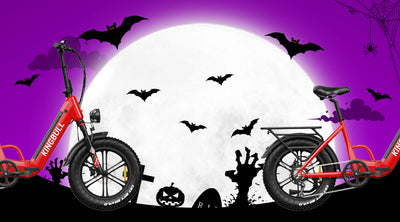
Purchase Guide
Halloween Adventure: Get Spooky with Kingbull Electric Bikes!
Halloween is just around the corner, and it’s the perfect time to hop on your Kingbull electric bike for a fun and thrilling ride! Here’s how you can combine the excitement of riding with the spookiness of Halloween, plus a special offer you won't want to miss!
1. Decorate Your Kingbull Electric Bike
Get in the Halloween spirit by decorating your Kingbull electric bike! Use black and orange streamers or stick on some fun Halloween decals like pumpkins, ghosts, and bats. Make your bike the star of the neighborhood this Halloween!
2. Ride to the Haunted House
Why not take your Kingbull electric bike to a local haunted house or spooky attraction? Gather your friends, enjoy the thrill of the ride, and get ready for some spine-chilling scares!
3. Night Rides with Halloween Lights
Halloween nights are magical! Add some fairy lights or a flashlight to your Kingbull electric bike for extra flair. As you glide through the beautifully decorated streets, you’ll be sure to enjoy the enchanting atmosphere.
4. Halloween Riding Party
Consider hosting a Halloween riding party! Invite friends to dress up in their favorite costumes and ride their Kingbull electric bikes around town to check out the Halloween decorations. You can even set up fun games like “Halloween Scavenger Hunt” to make it more exciting!
5.Safety First!
Remember, Halloween night can be busy with kids out trick-or-treating. Make sure your Kingbull electric bike lights are bright, keep your speed in check, and stay alert to ensure everyone stays safe.
6.Exclusive Halloween Offers
During this festive season, Kingbull is rolling out exclusive offers! Purchase any Kingbull electric bike and enjoy special discounts that will make your Halloween celebrations even sweeter. Don’t miss out on this fantastic opportunity to ride in style!
Conclusion
This Halloween, make your celebrations unforgettable with Kingbull electric bikes. Whether you're riding to a haunted house or joining a spooky riding party, you're in for a treat! Gear up, hop on your Kingbull, and get ready for a Halloween full of fun and excitement—plus don’t forget to take advantage of our exclusive offers! Happy Halloween! 🎃🚴♂️
Read more







